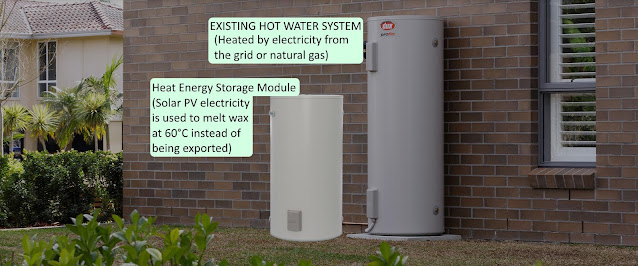No need for cold showers
Suppose a manufacturer made a simple home energy storage module that cost about half the price of a Battery Energy Storage System with similar capacity.
The module would be designed to store 10 kWh of output from a rooftop solar PV system - avoiding the need to export the 10 kWh for just a few cents for a feed-in-tariff. If your Feed-in-Tariff is 5 cents per kWh, you would forego this income by saving the energy and not exporting it. (This costs 50 cents per day for the 10 kWh that is stored in the module).
The module would avoid the need to purchase about the same amount of energy that it stored each day. If the retail price is 40 cents per kWh that you buy, then you could save this expense by using the 10 kWh of stored energy. (This saves $4 per day for the 10 kWh stored in the module).
A saving of $3.50 per day adds up to about $1,260 a year. In 5 years you should expect to save over $6,000 in energy bills.
This saving is about the expected cost of the Home Energy Storage Module that could store 10 kWh.
The energy stored in the Home Energy Storage Module provides enough energy each day to heat hot water used on average by a household of 3 (around 60 litres of hot water per person each day).
Because this stored energy is very cheap rooftop solar PV energy that would have to be exported for a low Feed-in-Tariff if it was not stored, there is no need, and little additional saving, in upgrading to a Hot Water Heat Pump System that costs around $5,500.
Cold water flows through the heat energy storage module where it is preheated, thanks to solar PV electricity that would otherwise have been exported for only a 2 to 5 cents feed-in-tariff, and then flows into an existing hot water system.
The existing hot water system will use little energy, either electricity or natural gas, when the water has been preheated by the heat energy storage module. Any time there is insufficient solar PV electricity, the existing hot water system will use a little more energy than usual. There will be no shortage of hot water because of a few cloudy days.
 |
| A heat energy storage module to preheat water and store solar PV output |
Arithmetic and Value for Money
An web page by the ACT Government "Singing in the shower – a guide to hot water heat pumps" recommends an upgrade to a Hot Water Heat Pump System. It includes some calculated annual energy cost comparisons and concludes the system cost of a system to heat 300 litres a day will be recovered in 5 to 6 years.
These calculations require an assumption about estimating the savings if the heat pump is to heat 300 litres of water a day. The comparison doesn't say what the assumptions are, or that on average, people use about 60 litres of hot water a day. If the Hot Water Heat Pump System is used to provide hot water for a home with 5 residents, the calculations are reasonable and the pay back period is likely to be around 5 to 6 years.
However, if only two people occupy the premises with the Hot Water Heat Pump System then the energy savings are for heating only 120 litres of hot water a day. With these lower savings, it would take 12 to 16 years for the savings to equal the cost of the Hot Water Heat Pump System.
The cost of a battery and a heat pump can be avoided with a much cheaper, and simpler appliance to store surplus solar PV electricity, and provide a return on the investment a lot faster.
See for example "heatBoxx : Optimized & effective heat storage made to measure", an application using phase change materials such as soy wax to store thermal energy that is used to preheat hot water before it enters your existing gas or electric hot water system.
If there is plenty of stored thermal energy in molten wax inside the thermal energy store, your existing hot water system will use little or no energy to finish heating the water to the required temperature. If there has been a long run of cloudy days, your existing hot water system will use a little more energy and still ensure adequate hot water is available.






